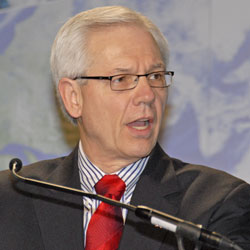 While California leads the nation in alternative fuel stations, pumps offering E85 ethanol and biodiesel are still extremely rare.
While California leads the nation in alternative fuel stations, pumps offering E85 ethanol and biodiesel are still extremely rare.
In fact, this Los Angeles Times story posted on Checkbiotech.org says that out of the 835 alternative fuel stations, 379 offer electricity, 215 pump liquefied petroleum gas, and 174 dispense compressed natural gas… with just a handful offering biodiesel or E85. But that could change:
Now, however, California has adopted ambitious new goals for alternative fuels and cutting greenhouse gas emissions – and it can no longer afford to leave the public out of the mix.For starters, the state is going to increase the use of ethanol as a fuel additive to all gasoline sold here.
For years, California’s gasoline has contained 5.7% ethanol to boost octane and comply with federal emissions rules; starting in 2010, that will rise to 10% ethanol. For a state that consumes about 43 million gallons of gas each day, that change alone represents a huge jump in ethanol consumption.
Meanwhile, biodiesel backers have helped build a statewide roster of more than 50 sites that offer the fuel, with many selling to the public and offering blends ranging from B10 (10% biodiesel and 90% petroleum diesel) to B99, a nearly pure biodiesel fuel.
New state and federal grants will help add E85 sites. In May, the state air board set aside millions to help set up 34 public E85 stations. Most are planned for the Sacramento area, but new sites will also open in the coming weeks in Carlsbad and Oceanside in San Diego County. Separate grants will fund new E85 sites elsewhere later this year.
But getting commercial stations on board might be a little tougher. The article says it costs about $50,000 to add E85 pumps. In addition, the big oil companies, which own most of the commercial outlets, are not warm to allow alternatives to petroleum to be sold at their stations.
GM, which has sold the largest number of the six million E85 vehicles on the road in the country today, is trying to help pump up the use of E85 by underwriting events such as selling E85 for just 85 cents a gallon in an effort to get more people to use the greener fuel.
 You can’t turn a corner at the 2008 Commodity Classic trade show without seeing something about ethanol. A record crowd is attending the Classic this year – more than 4450 people and over 140 media are in Nashville and the corn-fed enthusiasm is driven in a large part by the ethanol buzz.
You can’t turn a corner at the 2008 Commodity Classic trade show without seeing something about ethanol. A record crowd is attending the Classic this year – more than 4450 people and over 140 media are in Nashville and the corn-fed enthusiasm is driven in a large part by the ethanol buzz. Everybody who is anybody in the ethanol industry is here – the Ethanol Promotion and Information Council, Renewable Fuels Association, American Coalition for Ethanol, National Ethanol Vehicle Coalition, 25 by ’25 and more. Not to mention that ag input dealers from machinery to seed are touting products to help growers produce more corn per acre for both food and fuel.
Everybody who is anybody in the ethanol industry is here – the Ethanol Promotion and Information Council, Renewable Fuels Association, American Coalition for Ethanol, National Ethanol Vehicle Coalition, 25 by ’25 and more. Not to mention that ag input dealers from machinery to seed are touting products to help growers produce more corn per acre for both food and fuel. But its only just begun. Friday will feature Secretary of Agriculture Ed Schafer during the general session followed up by a John Deere Learning Center Session on Starch and Cellulose as Ethanol Feedstocks. And Saturday night everybody will be “Corn Fed” with a concert featuring the lovely and talented Shannon Brown.
But its only just begun. Friday will feature Secretary of Agriculture Ed Schafer during the general session followed up by a John Deere Learning Center Session on Starch and Cellulose as Ethanol Feedstocks. And Saturday night everybody will be “Corn Fed” with a concert featuring the lovely and talented Shannon Brown.


 The Ethanol Promotion and Information Council is now in the publishing business after announcing the introduction of “Ethanol Retailer” magazine this week. Robert White, Publisher, is pictured (center) during a panel he participated in on E85 during the National Ethanol Conference. I interviewed Robert about the new venture and the panel he was on.
The Ethanol Promotion and Information Council is now in the publishing business after announcing the introduction of “Ethanol Retailer” magazine this week. Robert White, Publisher, is pictured (center) during a panel he participated in on E85 during the National Ethanol Conference. I interviewed Robert about the new venture and the panel he was on. The sudden skyrocketing of wind energy production, especially in areas of the Midwest and rural parts of Texas and California, is outdistancing the the capacity for the nation’s high-voltage lines to get that clean electricity into the nation’s cities.
The sudden skyrocketing of wind energy production, especially in areas of the Midwest and rural parts of Texas and California, is outdistancing the the capacity for the nation’s high-voltage lines to get that clean electricity into the nation’s cities. The U.S House today approved $18 billion in new taxes on the oil companies that will fund incentives for renewable energy.
The U.S House today approved $18 billion in new taxes on the oil companies that will fund incentives for renewable energy. Buses in Central Florida will soon be running on a blend of their own biodiesel… a first in the country for any bus fleet.
Buses in Central Florida will soon be running on a blend of their own biodiesel… a first in the country for any bus fleet. The
The  Our Undersecretary for Rural Development, Tom Dorr, was first up on the program here this morning at the National Ethanol Conference to speak about the farm bill and focus on renewable fuel policies and provisions.
Our Undersecretary for Rural Development, Tom Dorr, was first up on the program here this morning at the National Ethanol Conference to speak about the farm bill and focus on renewable fuel policies and provisions. Florida Power and Light has picked up a $2.5 million state grant to help build a major wind power plant.
Florida Power and Light has picked up a $2.5 million state grant to help build a major wind power plant. While California leads the nation in alternative fuel stations, pumps offering E85 ethanol and biodiesel are still extremely rare.
While California leads the nation in alternative fuel stations, pumps offering E85 ethanol and biodiesel are still extremely rare. Government to Greenpeace will be taking part in the
Government to Greenpeace will be taking part in the